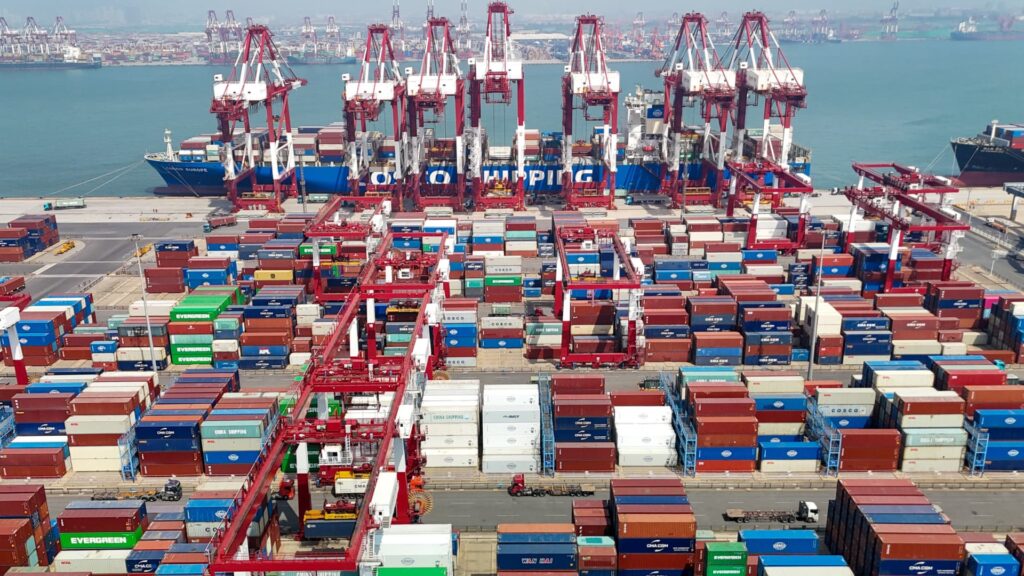The cargo yard of the Qianwan United Container Terminal of Qingdao Port in Qingdao City, Shandong Province, China.
Nurphoto | Getty Images
Businesses are finding a workaround to minimize the most significant hit from tariffs, using a decades-old piece of legislation known as the “first sale rule.”
Within U.S. customs law, the first sale rule allows U.S. importers to use the price of the first sale in a number of transactions to calculate customs duties.
For instance, a Chinese manufacturer sells a t-shirt to a Hong Kong vendor for $5. That Hong Kong vendor then sells the t-shirt to a U.S. retailer for $10. That U.S. retailer then sells the t-shirt to consumers for $40.
Under the first sale rule, the U.S. retailer can pay the import duty on the initial $5 price of the good, rather than the vendor’s inflated $10, thus stripping out the cost associated with the middleman’s profit.
“What the rules allow you to do is use that initial sales price from the factory to the vendor to determine the final duty price,” Brian Gleicher, senior lawyer and member at Miller & Chevalier Chartered, told CNBC over the phone.
How it works
The first sale rule has been around since 1988, but gained renewed attention under U.S. President Donald Trump’s first administration and, now, during his latest tariff regime.
“When the first administration had 25% tariffs [on China in 2018], that’s when we started getting calls. Now with the new tariffs, the first sale rule has started coming up again,” Sid Paruthi, partner at U.S. consulting firm Moss Adams, said over video call.
Everybody’s beginning to explore it with more interest.
Brian Gleicher
senior lawyer and member at Miller & Chevalier Chartered
“It’s been around for a very long time but … everybody’s beginning to explore it with more interest,” Gleicher said.
Here are the criteria businesses must fulfil to apply the rule:
There must be at least two sales involved: One from an overseas producer and one or more from an intermediaryThe sales must be carried out at arm’s length by independent and totally unrelated partiesThere must be proof that the item was destined for the U.S., rather than simply ending up thereThere must be documentation of the first sale price
For some companies, that can be easier said than done.
Typically, the default duty imposed by U.S. customs is based on the import price of a good, putting the burden of proof on the importer to demonstrate the initial cost of that item. That may not always be something a vendor is willing to reveal.
“If you’re an importer, you need to get that first sale price. You need to have the data,” Gleicher said. “Vendors may not want to give that information.”
Rich Taylor, a corporate business development consultant based in Chinese hub Ningbo who has been advising Fortune 500 companies on the first sale rule since Trump’s first term, noted “there has to be a level of trust between all parties” because of the risks involved.
Nevertheless, the additional complexities can be worthwhile, given the potential cost savings.
“You [suppliers] are keeping your customer. You’re showing them that you’re trying to give them every tool to reduce their cost,” Taylor said.
“If you don’t use it, then the end cost is going to go up. And if your competitor is using the [first sale] rule, then you’re going to lose you that advantage over them.”
Who’s using it?
Companies appear to be cluing into that.
While the first sale rule is broadly applicable across products and industries, it is considered particularly useful in higher-value consumer goods and luxury products, where margins are greater.
Last month, Italian luxury fashion brand Moncler flagged the first sale rule as providing “significant benefit” to its cost structure.
The industrial cost … is much lower than the retail price … it’s a significant benefit.
Luciano Santel
executive director & chief corporate and supply officer at Moncler
“First cost [sale], of course, the industrial cost … is much lower than the retail price, and it is about 50% of the intercompany price. So, of course, it’s a significant benefit,” Luciano Santel, executive director & chief corporate and supply officer at Moncler, told investors during an April 16 earnings call.
Swiss-headquartered biotech Kuros Biosciences earlier this month said that it was altering its operations, which would allow it to adopt the first sale policy.
“What we will now do is we will switch in between Zurich as a wholesaler hub… which in essence means we can adapt the so-called first sale method,” Daniel Geiger, chief financial officer of Swiss-headquartered biotech Kuros Biosciences, said during a May 13 earnings call.
During first-quarter earnings calls, U.S. BBQ-maker Traeger and manufacturing firm Fictiv also both cited first sale as “supply chain mitigants” and means to “minimize tariff and duty costs,” respectively.
Use of the first sale rule, while perfectly legal, nevertheless could undermine the Trump administration’s efforts to boost tariff revenue and boost onshoring of manufacturing.
The White House did not respond to CNBC’s request for comment on use of the first sale rule and its implications for tariff policy.
U.S. Customs and Border Protection said it could not provide data on the recent use of the first sale rule by importers.
— CNBC’s Ganesh Rao contributed to this report.

